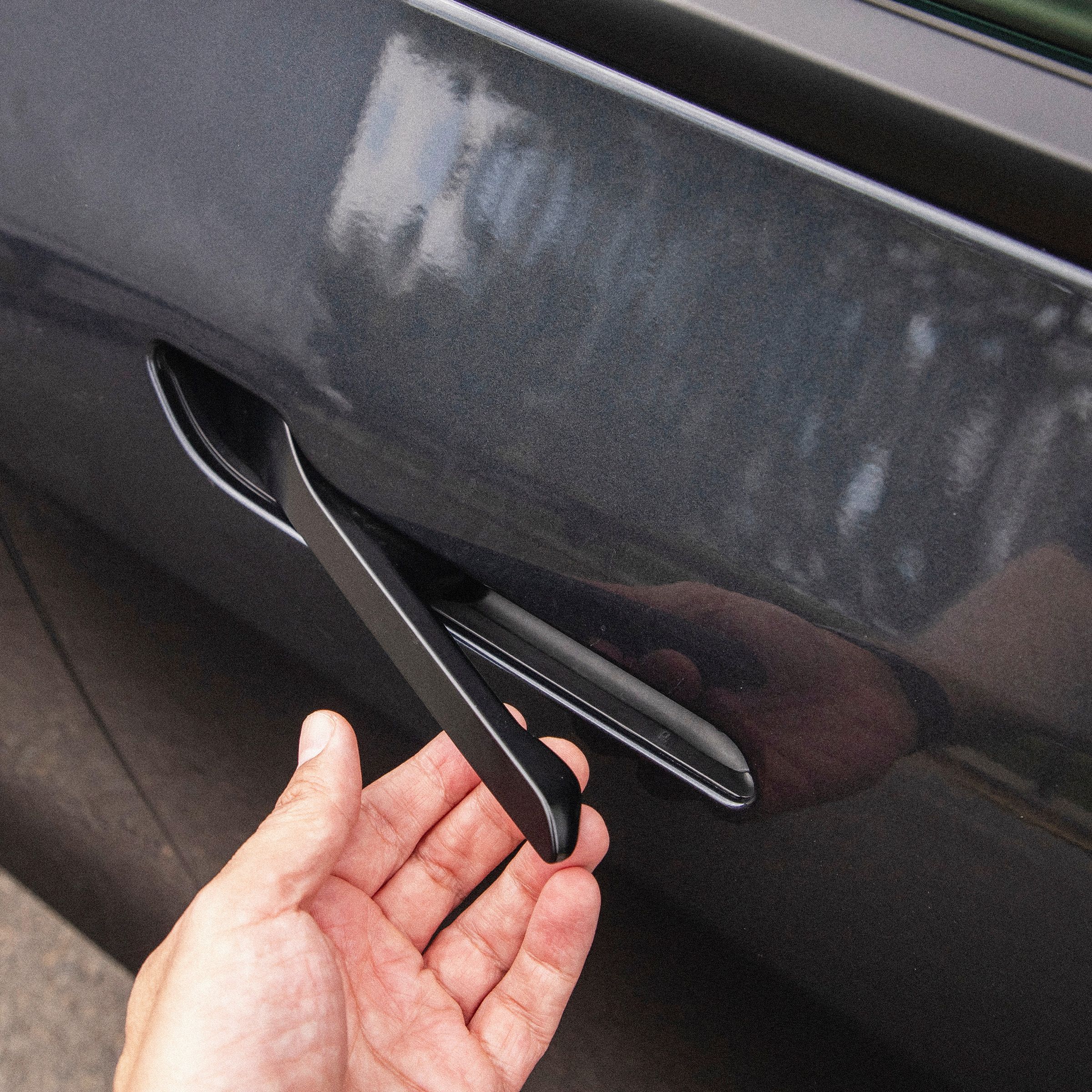Car door handles seem innocuous. Tesla’s electronic, retractable ones—since imitated by plenty of global automakers—have become a symbol of the automaker’s willingness to work from design-first principles, reimagining what the car of the future might look like, electric-style.
But in September, the National Highway Traffic Safety Administration launched an investigation into the Tesla 2021 Model Y’s door handles. More than 140 consumers have complained to the National Highway Traffic Safety Administration (NHTSA) about the door handles, according to a Bloomberg report published last month.
Drivers alleged the handles have gotten stuck or malfunctioned, especially when cars’ low-voltage batteries failed. Government filings highlight parents’ reports that their children were trapped inside their vehicles, unable to find or activate rear-door mechanical releases, after their adults exited the car. At least four alleged the need to “break a window to regain entry into the vehicle,” according to the agency. Tesla has since promised to redesign the handles.
On Friday, the family members of two California teenagers who died after the Cybertruck they were riding in caught fire in a crash sued the automaker, alleging that Tesla knew about the difficulties of manually opening its doors before the teenagers were trapped inside.
Now new Chinese regulations would force the door handle issue in the world’s biggest automotive market—rules that, given the size and power of China’s auto market, could soon show up in other parts of the world.
Handle Headaches
The proposed rules, posted by China’s Ministry of Industry and Information Technology last month and set to be finalized after a comment period in late November, would require mechanical release handles on the inside and outside of every car, which would have to be operable without tools after accidents. The rules also appear to nix flush door handles by requiring automakers to build the handles with enough room for a hand to grip behind them.
If the rules are finalized as written, they’ll kick in as early as mid-2027—a date that’s around the corner for many global automakers, given their multiyear vehicle design and development process.
Making door handle changes quickly could prove a pricey and complicated challenge. How pricey and complicated comes down to each automaker’s design. “There’s a real-estate problem in the door space,” says Amy Broglin-Peterson, who teaches supply chain management at Michigan State University’s Broad College of Business and consults in the automotive industry. Between the electronics, insulation, wiring for other parts, speakers, and other parts sandwiched into doors: “Any time you have design changes, that messes up other things,” she says.
The issues could cascade beyond the design. The auto manufacturing industry operates on strict production schedules. Though it builds in time to validate and test whatever new features come in each new model, the sudden intro of a design change late in the process could throw off the delicate timetable.
In this decade, China’s auto industry has shocked the world by racing ahead of legacy automakers, quickly developing, with government support, ever newer, cheaper, and more technologically advanced vehicles on shorter production schedules. The country is the world’s largest automotive market; it’s expected to manufacture a full third of the world’s cars by 2030. Still, quickly complying with new design regulations won’t be easy for domestic Chinese automakers either, says Broglin-Peterson. “Mechncial release requires a mechanical assembly,” she says. “It’s not just, you write some code.”
Automaker’s door handle trouble likely won’t end in China. The new rules could lead to cascading responses from other global regulators. It’s a now-familiar pattern: China, once a place with lax protections, has forged ahead of the rest of the world in setting guidelines for electric vehicle battery safety and recycling, and autonomous vehicle tech. “This is a classic example of China setting the guardrails early: protecting consumers while quietly shaping global design standards,” Bill Russo, the CEO of Automobility, a Shanghai-based advisory firm, wrote in an email.
A Handle on Design
For many years, says Raphael Zammit, the chair of the transportation design department at the College for Creative Studies in Detroit, flush electronic door handles were the stuff of futuristic concept cars. “The fact that Elon Musk and Tesla put it into production was, frankly, pretty amazing,” he says. Their rise was linked with the increasing popularity of electric vehicles; tucking door handles into the doors of cars was meant to reduce their drag coefficient, leading to increased battery efficiency. Or so the theory went: Back-of-the-envelope math suggests the tweak maybe adds a mile of range. Maybe. Either way, the handles became a “demarcation of luxury,” Zammit says.
Indeed, electronic door handles can be found on many luxury vehicles, including some made by Volkswagen, General Motors, Ford, and Mercedes-Benz. Jake Fisher, the senior director of the Consumer Reports’ Auto Test Center, tested several of those vehicles’ electronic handles. While all had emergency mechanical releases, as the Chinese regulations mandate, some were in places that could be difficult to find in an emergency—on the floor, in shadow, or, as in the rear seats of the 2021 Model Y under investigation by NHTSA, under a slot at the bottom of the rear door pocket. The best emergency mechanical releases, Consumer Reports found, were those that simply needed to be pulled a bit harder than usual to open, an intuitive reaction in an emergency.
It’s something Tesla seems to understand. “The idea of combining the electronic one and manual one into one button makes a lot of sense,” Tesla head designer Franz von Holzhausen told Bloomberg News. Indeed, the automaker will now be redesigning the door handle, combining an internal mechanical release with its electronic one. “It really helps the muscle memory of reaching for something that’s there every day, so you intuitively do the same thing” in an emergency, he said in an interview. Tesla, which disbanded its public relations team in 2020, didn’t respond to WIRED’s questions, including those about why Tesla didn’t make the changes sooner or whether the proposed Chinese rules would require further redesigns.
As with the door handles, “we do see automakers literally reinventing the wheel for no good purpose with mechanisms and designs that are demonstrably worse,” says Consumer Reports’ Fisher.
The US electric automaker Rivian is also reportedly redesigning the flush, electronic door handles on its next generation of SUVs and trucks, moving the rear manual interior release away from its current location behind an unlabeled panel. The automaker doesn’t sell vehicles in China. A spokesperson declined to comment on the report and wrote in a statement that Rivian’s current and future vehicles “meet or exceed all Federal Motor Vehicle Safety Standards, including passenger egress from all doors in the event of a crash or emergency.”
But automakers have declined to say how the Chinese rules will affect their designs. General Motors is reviewing and providing technical input to China’s Ministry of Industry and Information Technology, spokesperson Bill Grotz wrote in a statement. “Until the new regulations are finalized, we cannot comment on vehicle portfolio implications,” he wrote.
Mercedes-Benz spokesperson Yifei Wu wrote in a statement that Mercedes-Benz vehicles are designed to unlock and extend their exterior door handles when the vehicles’ air bag units detect a crash. “We are watching this topic closely and will of course adapt accordingly, if this [Chinese] proposal will change anything in the requirements,” she wrote.
Ford and Volkswagen didn’t respond to WIRED’s requests for comment. But last month, VW CEO Thomas Schäfer told the German DW News that its customers want mechanical buttons and handles that are easy to use. “It’s all nice to have these flush door handles, but they are terrible to operate,” he said. “We definitely have proper door handles on the cars, and customers appreciate it.”




